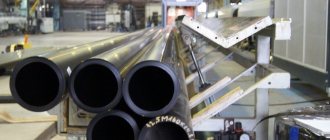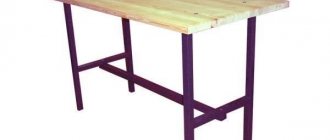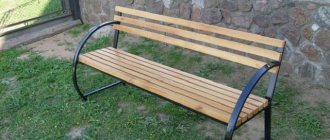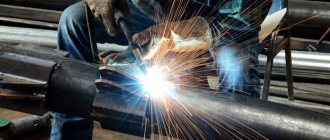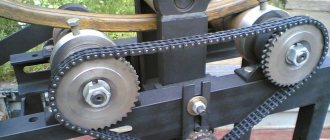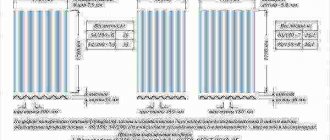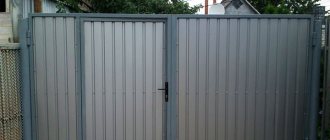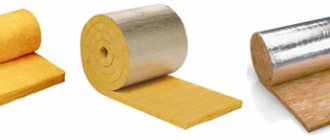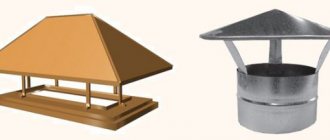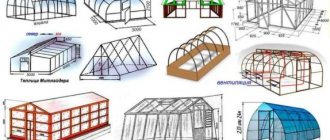Methods and technologies for bending HDPE pipes
Low-density polyethylene at normal temperatures is a fairly plastic material. For transportation, pipes are wound into coils of various diameters, so they must first be straightened before use. Polyethylene becomes plastic when the temperature rises to 80-135°C, so it needs to be heated.
There are many ways in which you can straighten or bend a polyethylene pipe:
- using a molding machine;
- using a hair dryer;
- using a gas burner;
- using hot water.
Each of these methods has its own advantages and disadvantages, and we will describe them all below.
Using a molding machine
This is purely industrial equipment. It is usually used for bending a large number of workpieces of not very large sizes - for example, elbows. The pipe is cut into blanks, placed in a frame made of fiberboard, chipboard and other available materials with a smooth surface, inserted into a silicone shell, heated to a temperature of 80-90°C, then bent and allowed to cool.
In reality, it is impossible to use such a machine for straightening a bent pipe; it also makes no sense to purchase it for your home.
Using a construction electric hair dryer
In order to straighten a wavy pipe, you should lay it out on a flat surface, heat it with a hairdryer and stretch it. Then let it cool in a stretched, even state. This work is best done together.
To bend the pipe, it is better to make a mandrel from bars and chipboard or fiberboard. The pipe is heated with a hairdryer as evenly as possible, rotating on all sides throughout the entire bent area. Then carefully bend it, being careful not to tear it; Place in a mandrel and allow to cool.
It is important not to overheat the workpiece, otherwise it will be too plastic when bent and may have insufficient strength when cooled. With strong heating, polyethylene can melt - after all, the melting point is 107°C.
Underheating of the workpiece will lead to its damage during deformation.
Using a gas burner
This is the riskiest heating method. The workpiece is very easy to melt, burn, even ignite. In addition, with strong one-sided heating, the surface of the tube may foam and become smoky. When heated in this way, it is easiest to get burned.
Without some experience, you should not use a gas burner. In any case, you should practice on scraps.
The technology for bending and straightening is similar to the technology for heating with a hairdryer.
Hot liquid treatment method
This method is sometimes used in production. The coils are immersed in baths of hot water, heated, taken out, rolled out on a flat surface and stretched. Let it cool.
At home, this method is used to bend pipelines with a diameter of less than 50 mm and not too long. Using a watering can (preferably steel), several liters of hot water are poured into the pipe - 80-90°C.
As soon as the workpiece warms up and becomes plastic, immediately bend it and place it in the frame, as in the case of heating with a hairdryer, and cool it.
It is problematic to straighten a long pipeline at home in this way - there is simply nowhere to take a large amount of slightly cooled boiling water at once.
other methods
To straighten a long section of pipe, in the summer you should use the traditional method: unwind it from the coil, lay it out and stretch it slightly (without fanaticism) in the sun, warm it up for 5-10 hours or more - the polyethylene will become more plastic. Then stretch (either with the help of an assistant, or secure the ends with clamps or some other method, and let it sit for a few more hours. In non-hot polyethylene, the process of relieving internal stress occurs slowly, and this work can take the whole day.
To heat the bay, you can use the steam room in the bathhouse.
There is also a way to bend small workpieces using hot salt or sand. Bulk materials are heated on a tray in the oven, poured into the pipe through a steel watering can (socket), wait until the workpiece softens, and bend it using a mandrel in the same way as the previous methods.
Which way is better
The easiest way is to heat the coil in the sun and stretch it. But this doesn't always apply. For small preparations, the method of heating with water is not bad - you can determine the temperature quite accurately (a pan of boiling water with the lid open will have a temperature of approximately 85°C in five minutes. You can also measure it with a thermometer). The method of heating with sand or salt is quite acceptable - if you measure the temperature and practice in advance.
If the household has a hair dryer, then it will have to be used to straighten long sections of polyethylene pipes.
Using hot baths and a molding machine at home is not possible. Using a gas burner is unsafe and difficult - there is a high probability of damaging the pipe.
The optimal and universal way to bend or straighten a pipe made of low-density polyethylene is using a construction hair dryer. This is what we will consider.
Additional manipulations with metal-plastic pipes for heating
How to bend a metal-plastic pipe
Installation of a heating system with metal-plastic pipes involves a wide range of manipulations, among which bending the pipe at the desired angle occupies a special place. This operation is performed manually or using a special device - a spring. It greatly simplifies the bending procedure and is affordable. In order to bend a metal-plastic heating pipe, a spring is placed inside it and given the desired bending shape.
The advantage of using a spring is that there is no risk of excessive deformation of the walls. In addition, this device does not make it possible to make too sharp a bend, which will reduce the permeability of the pipe. This method allows you to give the product the desired shape without much effort. If necessary, the resulting bend can always be adjusted.
When bending a metal-plastic heating pipe manually, certain rules must be followed. Bending should be done smoothly with two hands, which should be located equidistant from the middle of the bend. In this case, with your thumbs you need to press upward on the pipe from the bottom, and lower its edges down. The procedure must be performed carefully, since due to excessive efforts, the geometry of the pipe section may be lost, which will reduce its flow area. This situation can be prevented by heating the bend area with a hair dryer, which is used in construction operations.
There is one more “secret” that will allow you to avoid “kinks” in the heating pipe. To prevent its walls from breaking, sand is poured into the pipe before bending.
How to attach metal-plastic heating pipes to walls
The use of metal-plastic pipes in heating systems involves fastening the pipeline to the wall using clips. Such fittings can have a single design (for installation of a single heating branch or water supply networks) or a double design (for two-pipe installation of heating with a “return”).
Installation of fasteners (mounting clips) must be done at least every 100 cm. Installation of clips is carried out in specially prepared holes using dowels. When marking places for attaching clips on the wall, it is necessary to ensure the same height from the floor surface.
Read material on the topic: Do-it-yourself heating in a private house
Non-standard connections with metal pipes and transition to a different diameter
When reconstructing or repairing heating systems, it is often necessary to solve the problem of connecting metal-plastic pipes with steel products. This occurs when it is necessary to arrange outlets from the riser. Preparation for this type of fastening involves cutting threads on a metal pipe to screw on a fitting with an internal threaded connection or collet. When making this connection, it is necessary to ensure its sealing using fum tape or special paste.
Using the same technology, you can install pipes with different diameters. In this case, you need to select an adapter with nuts and nipples of the required size.
Tip: for fittings and metal-plastic pipes for heating, sizes and prices may vary from different manufacturers. Even experienced craftsmen can make mistakes when selecting the right products. Therefore, you should check with the seller in advance about the possibility and conditions of a return or replacement. Of course, the remains of a metal-plastic pipe cannot be returned. Therefore, it is necessary to take measurements responsibly.
Technical specifications for metal-plastic pipes for heating remain standard, which guarantees their trouble-free operation. Troubles can only happen if installation is not professional. Therefore, before starting the heating system, it should be tested under high pressure. This procedure is called “pressure testing”. To carry it out, cold water is supplied to the system and, in places where leaks occur, the connections are “tightened”.
DIY bending process
There is not always hot sun, hot water and sand, a home bath or sauna. In this case, a hair dryer will come to the rescue of the home craftsman. With its help, you can bend a short piece, you can straighten a long piece for external plumbing, or you can bend it.
Required tools and materials
To perform bending you will need:
- construction hair dryer;
- workpiece;
- mittens;
- mandrel. The mandrel is made of bars stuffed onto chipboard, OSB, fiberboard (for small diameters).
Work progress
- the workpiece is heated in the area that will be bent; for uniform heating, the workpiece must be rotated;
- then you need to smoothly bend the pipe, then lay it in the frame;
- let cool, stand for a few minutes;
- then remove and let sit for at least 15 minutes.
How to bend a metal-plastic pipe?
Metal polymer is a flexible material that can be easily deformed by hand. However, in order to bend them without damaging the inner layer, without reducing the throughput, the following devices should be used:
- Spring. Special springs for bending metal-plastic can be purchased according to the diameter of the selected material. It is inserted into the place of the intended bend and then worked with your hands.
- Sand. If you fill a pipe with sand, it, like a spring, will prevent the inner layers from deforming. The main condition is that the sand must fill the entire volume tightly.
- Crossbow pipe bender. It is used according to the instructions.
- Construction hairdryer. Use a hairdryer to heat the material before bending it with your hands. Temperature makes plastic and metal more malleable, which prevents possible damage.
The arm bending technique is as follows:
- The thumbs of both hands are placed point-blank at the bottom in the center of the intended bend. They create tough resistance.
- The remaining fingers are placed wide apart and gently press down on the pipe.
Craftsmen, as a rule, make small bends in small-diameter pipes without the use of special devices. However, for this you need to have extensive work experience and feel the material.
Expert advice
Don’t forget about safety precautions - gloves, and when working with a burner, a tarpaulin suit is required! Beware of burns.
After cooling, you should let the polyethylene sit for a few more minutes to release the internal stresses in the plastic.
To straighten a long pipe, it is not necessary to heat it completely; it is enough to heat only a few sections.
Low-density polyethylene is afraid of ultraviolet radiation - it is usually laid underground, in dark basement floors. Where there is ultraviolet radiation, polypropylene pipes or polyvinyl chloride are used.
Example of water supply system layout
First, we draw a water supply layout plan. This can be done on a piece of paper, marking the necessary fittings. Please note that installation of taps requires installation of a fitting with a thread at the end. Taps are needed on taps to household appliances and plumbing fixtures, to heating radiators. This makes it possible to turn off devices without shutting down the entire system. The type of thread and its size are selected depending on the type of tap used.
An example of a water supply system using metal-plastic pipes
Also, transition fittings are needed before and after the meter (water or heating depends on the type of system). Having drawn a detailed plan, put down dimensions on all areas. Using this drawing, you calculate how much and what you need. Fittings can be purchased strictly according to the list, and it is advisable to take pipes with some reserve. Firstly, you could make a mistake when measuring, and secondly, in the absence of experience, you can spoil some piece - cut off less than required or crimp incorrectly, etc.
Agree on the possibility of an exchange
When purchasing everything you need, agree with the seller that you can exchange/return some fittings if necessary. Even professionals often make mistakes with them, and even more so those who decide to do the wiring of a plumbing or heating system from metal-plastic with their own hands. No one will take the rest of the pipe back from you, but fittings will easily be taken back. But to be sure, keep the receipt.
Sometimes it is more convenient to use collectors. They allow you to connect several consumers in parallel. There are collectors for plumbing and for heating (when installing heated floors)
When and how to start work
When you get home, lay out the fittings and proceed: installation of metal-plastic pipes in the summer can be done immediately, in the winter you need to wait some time (12 hours) until all the elements warm up to room temperature. It is advisable to cut one piece of pipe of the required length at a time. It's a little longer, but you definitely won't get confused. Further actions depending on the selected type of fittings.
Heating installation with metal-plastic pipes is done only with press fittings
After completing the installation of metal-plastic pipes, the pipeline is checked. If it is a water supply, just open the tap at the inlet. This must be done gradually and smoothly. The system will immediately begin to fill with water. If nothing leaks anywhere, you did everything right. If any connections are leaking, they must either be redone if press fittings were used, or tightened if the assembly was based on crimp connectors.
If a heating system was assembled from metal-plastic pipes, before starting it must be pressurized - tested with high pressure by pumping cold water into the system. If the test was successful, you can do a test run of the heating.
Common mistakes
The main mistake is overheating the workpiece or insufficient heating. In the first case, the polyethylene will begin to melt (the melting point of HDPE is only 107°C), in the second, the inner layer will not warm up, and the polyethylene will be brittle and burst when bent. If overheated, the workpiece will be too plastic and, when cooled, will have insufficient strength.
Our video will help you understand the intricacies of installing low-density polyethylene products:
A polyethylene pipe with a diameter of up to 90 mm should be bent in no more than forty seconds.
When heated with a gas burner, there is a high probability of ignition of the polymer.
It is undesirable to bend the workpiece at an angle greater than 90 degrees - there is a high probability of damage to the bend.
The minimum bending radius when bending in a hot state must be at least three outer diameters.
How to attach metal-plastic pipes to walls?
To secure a pipeline made of metal-polymers, there are special plastic clips or brackets. Select fasteners according to the diameter of the pipe. They are attached to the walls where communications are laid.
The distance between the fasteners is 1 meter. At the same time, in places of bending, fastenings are made on both sides.
Features of HDPE pipes
Polymerization of pipe products gives them additional resistance to corrosion and chemical influences. HDPE pipes are lightweight and easy to transport and install; they are also reliable and can serve for a long time.
Low-pressure plastic pipes are used for sewer and water supply lines, including for supplying drinking water and technical fluids.
However, they are vulnerable to high temperatures, and already at 800 C they become soft, and at higher temperatures they turn into a shapeless plastic mass.
What are the advantages of metal-plastic pipes for heating?
In the market of construction materials, metal-plastic pipes for heating have made a real revolution. Thanks to their unique characteristics, they immediately became products in high demand. They are used to connect various communications. If you are planning to assemble heating for a private home, metal-plastic pipes will be the most acceptable option in terms of price/quality ratio. They are distinguished by ductility, low weight, corrosion resistance and high strength.
The price of metal-plastic pipes for heating is quite low. They are aluminum products with a protective polyethylene coating on both the inside and outside. The seam connection of a metal-plastic pipe is made using laser welding. In rare cases, ultrasonic lap fixation technology may be used.
Metal-plastic heating pipe design:
- polyethylene inner layer;
- adhesive composition;
- aluminum frame;
- adhesive composition;
- polyethylene outer layer.
The inner surface of metal-plastic pipes is so flat and smooth that it is not able to accumulate salt deposits and become covered with rust. This ultimately eliminates the likelihood of a leak.
The plastic on the outer part of the metal-plastic pipe protects the surface of the product from mechanical damage and the negative effects of condensation. For reliable adhesion of polyethylene to aluminum, a special adhesive composition is used.
Most manufacturers independently develop an adhesive composition and implement it into the technological process. As a rule, such adhesive compositions are patented. Therefore, the names of all components included in the product are not disclosed to consumers. Almost all operational and technical characteristics - flexibility, strength, durability - depend on the adhesive composition and how long it is able to retain its properties. If during operation the adhesive composition loses its quality, the pipe begins to delaminate and the likelihood of leakage increases. Well-known manufacturers do not use low-quality glue in the production of their products. Therefore, they produce the best metal-plastic pipes for heating with a long service life.
Cross-linked polyethylene
used for the inside of metal-plastic pipes. The use of PEX provides products with maximum strength and durability. Mechanical cross-linking of this brand of polyethylene promotes the formation of the required number of bonds in the molecules, which increases the strength of the product. Cross-linking can be carried out in all directions, thanks to this it is possible to create molecules with the required number of atoms.
Adhesive composition
promotes strong adhesion of the aluminum component to the polyethylene layer, which gives the metal-plastic structure strength. This composition is used for gluing the second and fourth layers. Since polyethylene and aluminum have different coefficients of linear thermal expansion when heated, it is natural that during operation they expand unequally. Different expansion coefficients when heated create tension. This property is completely neutralized by the adhesive composition.
Aluminium foil
used as the third layer, which is the main one. Pure or alloyed aluminum is used in the production of products. The surface of the products is a heavy-duty polyethylene layer. If necessary, this can be polyethylene with high heat resistance PE-RT/Al/PE with a large number of carbon atoms performing a binding function.
The technological process of manufacturing tubular products is always aimed at increasing the strength and practicality of products. The main characteristics include the presence of an anti-diffusion layer and resistance to the effects of heated coolant. The special composition and design features of metal-plastic pipe products do not allow them to deform when heated. Thanks to this, metal-plastic heating pipes increase the service life of heat pipes several times.
How and why pipes are bent
Pipe bending technology is based on the properties of the polymer to take any shape under the influence of high temperatures.
It is necessary to bend the pipe and to give the desired bend shape when installing a pipeline, which can have a different configuration, so as not to use additional connecting parts, you can simply give the pipe the desired shape using its technical properties.
This is achieved using special heating equipment in the form of a molding machine, a hair dryer or a gas burner:
- The operating principle of the molding machine is to use a special frame made of wood board, into which a pipe is fixed, placed in a silicone shell created by the machine. When heated, the pipe takes on the shape of a frame. It is cooled for 10 minutes and then taken out and left to cool completely.
It is important! The surface of the frame is carefully ground and cleaned of irregularities and defects to protect the pipe from possible damage.
- Bending with a hair dryer or a gas torch occurs in a similar way, but has its own characteristics. The procedure also requires a chipboard form in which the desired configuration of bends is outlined. Then the pipe at the bend is heated evenly on all sides. To do this, rotate it slowly, trying to ensure uniform heating of the product. After that, a pipe is placed in the prepared template and slowly and gradually begins to bend it at the required angle. It is important to ensure that you do not accidentally damage the pipe at the bend point. Leave the product in this form until it cools completely.
Note! If the distance of the burner or hair dryer from the pipe is too large, the softening will be insufficient, which can lead to damage to the material, and if the equipment is located too close, the polymer may ignite.
Technical characteristics of metal-plastic pipes for heating
- Resistant to temperature loads up to 950C.
- The operating pressure is at least 10 atmospheres.
- The service life of metal-plastic heating pipes directly depends on the temperature of the transported agent. At a constant coolant temperature (95°C), the service life of the pipeline will be more than a quarter of a century. The coolant temperature can rise to 110°C only for a short time due to the low heat resistance of the product.
- During the day, oxygen diffusion is 0 g/m³.
Advantages of metal-plastic pipes for heating (technical characteristics and operational properties):
- low heat transfer coefficient. Pipes made of this material heat up slowly, which reduces heat loss;
- due to the minimal roughness of the inner surface, low hydraulic resistance of the pipeline is ensured;
- a heating system made of metal-plastic pipes can be installed independently, as it will be light in weight;
- simple installation technology. To ensure reliable connection of pipes made of this material, metal fittings are used. The use of high-quality fittings guarantees a long service life of the heating system.
Full information about the characteristics of heating pipes made of metal-plastic can be obtained from the markings:
- protective coating: pe-r (polyethylene), pp-r (polypropylene), pex (made of high-strength cross-linked polyethylene), pe-rt (made of heat-resistant polyethylene);
- pipe diameter in millimeters;
- soldering option – a (pyroxide), b (silane), c (electron bombardment), d (nitrogen method);
- operating pressure;
- manufacturer's marks: production time, brand, batch, production equipment no.
Read the material on the topic: Pipe quality as the main parameter for choosing materials
Methods and recommendations for straightening
For the installation of external pipelines, pipes with a diameter of no more than 180 mm are often used, which are most often supplied to the pipe consumer in twisted form. This allows you to install lines without the use of additional connecting elements. To do this, you simply need to straighten the pipes. There are several methods, the choice of which depends on weather conditions and the experience of the master.
Experts recommend taking into account when straightening pipes that any deformation or damage can negatively affect the performance of the entire pipeline.
Natural straightening in the sun
The easiest way to do this is in the summer, the plasticity of the material increases under the rays of the sun and it is enough to simply leave the pipe in a straightened state for a while, firmly securing the ends so that it straightens and all the creases disappear. This is the most cost-effective method, which is most often used for installing lines.
Heating with water or air
During the cold season, hot water or targeted exposure to warm air can be used to heat the pipe. Heat treatment is carried out in the same way as in the first case, only instead of sunlight, heating occurs using irrigation with a stream of hot water or blowing with heated air.
For the installation of large lines, special equipment is used in the form of a trolley with an aluminum frame. This method is suitable for straightening pipes with a diameter of 14-20 mm. Rotating rollers gently remove creases.
Note! It is important to pay attention to the choice of heating equipment. Ideally, it should be equipped with a temperature controller or air flow control device, and also be able to operate in several modes.
Many craftsmen use improvised means rather than special equipment to straighten pipes. For example, salt or sand. The heated substance is poured inside, one end of which is closed with a barrier lid.
This way the pipe heats up and it is easy to give it the required shape. It is important to correctly calculate the temperature of the bulk mass; it should not exceed the temperature when the material begins to turn into a viscous mass , i.e. the temperature exposure should not exceed 80°C.
It is important that the funnel for pouring sand or salt and the barrier lid are made of metal. You cannot apply great effort for extension; movements should be smooth, but not sharp.
How to install metal-plastic pipes with compression fittings
A water supply system made of metal-plastic pipes includes connecting elements called fittings.
Connecting elements
What types of compression fittings are there for metal-plastic pipes? How to install them correctly? What to do if the connection starts to leak? You will find out the answers to these questions by reading the article.
Problems of choice
A metal-plastic pipe is a thin-walled aluminum (approximately 0.5 mm) tube with an inner and outer shell made of cross-linked polyethylene.
The structure of the pipe is often indicated in the markings.
Aluminum increases the mechanical and hydraulic strength of the pipe. However, it also creates a number of problems during installation:
- A bend with too small a radius may cause the aluminum tube to break. In this case, the maximum operating pressure of the metal-polymer pipe drops sharply;
A bend with an excessively small radius resulted in a core fracture.
- Since pipes of small diameter are sold in coils, after straightening they retain the ovality of the cross-section acquired during coiling;
The straightened pipe from the coil takes on an oval cross-section.
- When cutting, the edge of the pipe is crushed, again deforming.
Ovality of the pipe end is the main problem that leads to joint leaks after assembly.
Currently, you can find three types of fittings in stores.
Compression
The pipe is crimped onto a brass fitting with two rubber sealing rings and a fluoroplastic thrust washer. It is compressed by a split ring, which, in turn, is compressed by a union nut with a conical internal profile.
The mechanism of operation of the fitting is simple and clear:
The mechanism of operation of a compression fitting.
The main advantage of this type of fitting is the combination of the low cost of the connector itself and the availability of tools. For assembly, you need an adjustable or open-end wrench, which is used to tighten the union nut, and a clamp/vice/second wrench to secure the housing.
I assembled all the connections using a simple set of two adjustable wrenches.
If necessary, the connection can be disassembled and reassembled on a fitting of a different configuration.
The main disadvantage is the notorious leaks at the connections. If metal-plastic stands in cold water for years without complaints, then in hot water and heating it starts dripping after a while. Once you tighten the nut, it will stop, but later it may start again.
Typical leak location.
Let's put this type of fitting aside for now and look at the alternatives.
Press fitting
The design of these products is very similar to that described above, but with several modifications:
- Rubber O-rings have a lower profile and are recessed deeper into the grooves;
- There is no split ring;
- Instead of a union nut, the pipe is fixed to the fitting with a stainless steel sleeve. It is crimped during assembly using pliers with a large lever arm. After installation, the connection is made permanent.
With very few exceptions, connections of this type do not leak after assembly. If the plumbing or heating system has passed hydraulic tests, the connections can be laid in a screed, walled into a wall or hidden in plasterboard partitions.
The main disadvantage is the price of the tool. The simplest pliers from Valtek for diameters 16 - 20 mm can be purchased for about 6,000 rubles; universal pliers for diameters 16 - 32 mm cost from 10,000 to (just don’t be alarmed!) 80-90 thousand rubles. Agree that for a one-time replacement of the water lines in an apartment this is somewhat excessive: a full set of pipes and fittings will cost much less .
Push fitting
Push connectors (from the English push - press) simplify the process of assembling the connection extremely: in the advertisement, the plumber inserts the pipe into the socket with little effort, after which the connection is assembled and securely fixed.
In practice, the assembly process is somewhat more complicated.
How to connect metal-plastic pipes to each other using push fittings?
Push connection installation instructions.
- Inside the push fitting there is the same fitting with O-rings as in a compression product. In order not to tear off the rings, the pipe must have a perfectly round internal cross-section and a chamfered internal section, ensuring a smooth fit into the fitting;
- Fixation and the absence of reverse movement of the pipe is ensured by a stainless ring with legs directed towards the fitting. Alas, the dimensions of the ring are designed for a strictly defined pipe wall thickness. If they are slightly thicker, the pipe will be difficult to insert into the connector; if it’s a little thinner, the pipe will be torn out with significant force;
Brass push fitting device.
- These products are noticeably more expensive than competing solutions. Let’s say, a coupling with a diameter of 16 mm with two compression or press fittings costs from 60 to 100 rubles, and with two push fittings it costs about 150.
Push-fit coupling 16 mm, wholesale cost 144 rubles.
Review of leading manufacturers
A large number of domestic and foreign manufacturers present their products on the domestic construction market; it is quite difficult to determine which is better. The most famous are:
Rehau. The German company Rehau was founded in 1948 in the city of Rehau. The concern supplies the domestic market with Rehau pipes made of cross-linked polyethylene PEX and metal-plastic PEX-AL-PEX of the Rautitan system; a distinctive feature of the products is the ability to withstand temperatures up to +110 C.
Among the German companies on the market, Wefa Plastic (city of Attendorn) and Aquatherm GmbH (Aquatherm), Oventrop are well known.
Rice. 13 Fittings for metal-plastic pipes from well-known manufacturers
Nanoplast. A well-known domestic manufacturer that produces high-quality sanitary fittings in compliance with international technical and hygienic standards, the products are in good demand among the population. Among domestic manufacturers, the companies Politek and PRO AQUA supply a wide range of sanitary fittings to the market.
Valtec. A joint Russian-Italian concern with enterprises in Russia and Italy, supplies the consumer with pipes and fittings for metal-plastic pipes in a wide range of products according to international quality standards.
Pilsa. The Turkish company, whose products have an optimal price-quality ratio, also supplies their products to the domestic construction market from other Turkish companies: Firat, TEBO, Kalde.
Metal-plastic pipes can be easily aligned manually by placing two thumbs connected together at the bottom of the pipe and smoothly bending it with your hands, resting it on the surface of the finger arch.
A more reliable method of bending is the use of spring pipe benders, which are located both inside the pipe and on its surface; bending is also done using physical force of the hands.
Rice. 14 Bending MP pipe
The main methods of installing fittings for MP pipes are pressing and crimping; modern push connections have not yet gained popularity and widespread use in the construction industry. When installing a water supply system, pressed lines, as the most reliable in terms of connection method, are usually placed in the walls, and crimp lines are installed on the surface, so that if the union nut is loosened, it can be slightly tightened after 7-10 years.
Subtotals
Obviously, for a person who has decided to change the water supply wiring with his own hands, the ideal option is metal-plastic with compression fittings. They are cheap in themselves and do not require expensive tools for installation. More precisely, this choice would be ideal if it were possible to solve the problem of hot water leaks.
Metal-plastic water supply on press fittings? Great choice!
Benefits of using plastic
Metal communications were the most popular a few years ago. They have high levels of rigidity and strength, are durable and do not require maintenance. But at the same time, the metal is susceptible to corrosion, which is inevitable in the sewer system. On steel and cast iron pipes, under the influence of chlorinated water, various mineral “plugs” are often formed, which negatively affect the entire operation of the drain.
Photo - metal-plastic sewerage installation
Advantages of metal-plastic pipes:
- Excellent durability. They do not rust and salts do not accumulate on their inner walls. Apart from this, they also facilitate the disposal of solid waste;
- Frost resistance. Unlike conventional plastic analogues, such pipes do not crack due to temperature changes or when water freezes in them. They also do not deform;
- Easy to install. The technology for installing sewer plastic pipes does not require the use of complex devices, for example, a heavy welding inverter; they can be inserted directly into the desired location of the pipeline using a simple fitting or adapter;
- Availability. At the moment, the price of such communications is much lower than stainless steel ones. Sales are made in all cities (Samara, Moscow, St. Petersburg, Rostov-on-Don and others), they can be found in almost every plumbing store.
But at the same time, metal-plastic pipes for water supply require very careful handling. They are a layered material, where the first layer is a special polyethylene, the second is a reinforcing metal fiber, and the third is a rigid polymer plastic. These types of communications are very sensitive to sudden impacts or falls, so during installation you must follow certain rules.
In such communications there is a hidden gasket that increases the tightness of the system. If its integrity is compromised during installation, the sewer will begin to leak air, which will reduce its efficiency. You also need to comply with certain standards specified for the installation of any type of pipe in GOST R 50838.
Video: connecting metal-plastic pipes
Restrictions
The purpose of writing this article is to explain how to properly connect metal-plastic pipes using compression connectors and avoid leaks. However, first it is worth mentioning a few limitations associated with metal-plastic in general.
Metal-polymer pipes cannot be used:
- In central heating systems;
- In centralized hot water supply systems to the valves in the apartment.
The maximum operating parameters for a typical metal-polymer pipe are a pressure of 16 kgf/cm2 and a temperature of 90-95 C. It seems that the standard parameters of heating and hot water systems fit into these standards with a good margin:
- The temperature of any utility networks in a residential building is limited by the current SNiP at 95C;
Heating flow and return temperatures depending on the outside temperature.
- The pressure in the hot water system most of the year is 5-6 kgf/cm2, in the heating system - 3-4 kgf/cm2.
However, the world, alas, is not ideal: in some cases, normal parameters can be exceeded, and significantly.
Here are some examples of such situations that I have personally encountered on numerous occasions.
Prices for materials and services
On average, services for laying a metal-plastic water supply system will cost you at least 3,000 rubles (excluding the cost of materials). The price will vary depending on the complexity and volume of work.
One linear meter of metal-polymer pipe (16 mm) costs an average of 75 rubles , with a diameter of 26 mm - 185 rubles. The price range of fittings is from 109 to 300 rubles.
The installation methods described above will be performed by a man who has minimal skills. Balance your strengths and capabilities. And know that the final result depends only on your desire and effort!
Compression fitting: fast, simple, reliable
Cause of leaks
So, we returned to our old friends - compression fittings. Why are they leaking?
Because ease of assembly often plays a cruel joke on the installer:
- Among the tools, the would-be locksmith only stocks up with an adjustable wrench;
- Instead of metal-plastic scissors, a hacksaw or even a garden saw is used to cut the pipe. In the best case, the burrs are removed from the cut;
- The chamfer is not removed, and the pipe is not calibrated, maintaining an oval cross-section;
- As a result, at the moment when the pipe is put on the fitting, it tears both ring seals out of the grooves and displaces them towards the thrust fluoroplastic washer.
When tightening the nut, the pipe does not compress the seals, but the surface of the fitting. Since cross-linked polyethylene is plastic, this is not a problem: the connection becomes airtight.
However, when the softening temperature of the plastic is reached, the pressure of the split ring squeezes it out of the gap between the aluminum pipe core and the fitting. The situation is aggravated by thermal expansion. As soon as the water in the pipe cools down a little, a leak appears, which is eliminated by tightening the nut - until the next heating and cooling cycle.
In some cases, the leak will stop completely when the fitting is tightly pressed with a soft aluminum core. More often than not, the next time you try to tighten the union nut, the thread underneath it breaks off.
Correct assembly
All you need to do is assemble the connection so that the pipe, with moderate force, compresses the rubber rings, and not the fitting itself. To do this you need to follow a simple sequence of actions:
- Cut off the pipe. Ideally, use metal-plastic scissors; however, a hacksaw will still work;
- Remove internal chamfer and remove burrs;
- Align the pipe with a calibrator. It should be perfectly round ;
Many calibrators have chamfering knives.
Universal calibrator with chamfering knives from Valtek.
- Place the union nut and split ring on the pipe;
- Apply a little liquid soap to the fitting;
- Push the pipe all the way onto the fitting, making sure that the rubber rings do not come out of the grooves;
- Move the split ring and union nut to the end of the pipe;
- Tighten the nut until you feel resistance. A squeaking sound when tightening the nut is normal. In this case, the fitting must be held with a second key or clamped in a vice.
The connection assembled in this way can be used for hot water and heating (of course, with the restrictions specified above) for an unlimited time without leaks..
Useful little things
How to connect a metal-plastic pipe with a metal one (for example, after a valve and filter at the entrance to an apartment)?
It is better to make the connection quick-release: sooner or later the valves will have to be changed, and the ability to clean the liner if it is clogged will not be superfluous. For the connection, an American is used - a fitting with a regular fitting for metal-plastic, a thread and a detachable connection with a union nut between them.
The photo shows a detachable connection between metal-plastic and polypropylene.
How to connect a metal pipe with a plastic one where disassembly is not necessary?
A straight coupling or an angle with a metal-plastic fitting at one end and a pipe thread at the other is used.
Angle adapter from metal-plastic to pipe thread.
To seal threads I use:
- Tangit Unilok or any other polymer sealing thread;
- Plumbing linen impregnated with nitro paint or silicone sealant. Impregnation prevents rotting of organic fiber.
I strongly do not recommend using FUM tape for winding metal threads: with minimal reverse thread movement, the connection starts to leak.
How to install metal-plastic heating pipes
After the information provided in the first chapters of the article, the question naturally disappears: is it possible to use metal-plastic pipes for heating? These products are ideal for installing heating systems in residential and industrial buildings.
When deciding to use this option for pipe products, it is necessary to determine what diameter of the metal-plastic pipe is needed for heating. The manufacturer's product labeling indicates the outer diameter. To calculate the cross-section, subtract the width of the pipe walls from this indicator. For example, for metal-plastic products with an outer diameter of 0.2 cm, the cross-section is 0.16 cm.
It should be noted that metal-plastic pipes and fittings for heating have one design drawback. With each subsequent connection, the internal cross-section of the line decreases. Therefore, for an extended connection of metal-plastic pipes, it is necessary to select technical solutions for expanding the pipeline or install pumping equipment.
Preparation for installation
First, a diagram of the future pipeline is drawn on paper, with distribution throughout the room and designation of fitting installation locations. When drawing up a diagram, it is necessary to take into account that for the installation of taps, fittings with threads at the end must be provided. Installation of taps is carried out in places where coolant is discharged from heating radiators, which makes it possible not to turn off the heating system completely, but to turn off only those devices that are necessary. The type and size of the fitting thread must match the faucet model.
Installation of transition fittings is also necessary for installing water and heating meters, which are selected taking into account technological features. When drawing up a diagram, fitting parameters are indicated in all areas, which makes it possible to purchase the required number of elements of the required size. Using such a drawing, you can not only determine the number of parts, but also carry out heating from metal-plastic pipes with your own hands. Purchasing fittings according to the list helps to save the budget, but it is better to buy pipes with a small margin, since unnecessary cutting and damage to the products may occur during the installation process.
Read material on the topic: Installation of heating from polypropylene pipes
Tools
To install a plumbing and heating system, in addition to fittings and pipes, you will also need:
Pipe cutter
In appearance, this device resembles ordinary scissors. The special design of the pipe cutter facilitates the formation of a cut with the desired angle to the axis - 900. This tool is used not only for cutting metal-plastic pipes, but also other types of pipes.
Calibrator
(caliber) is intended for metal-plastic products. When cutting, as a rule, the edges of the pipe are bent inward, and it is slightly flattened, which spoils its aesthetic appearance and complicates the installation process. Therefore, the main purpose of the calibrator is to restore the shape of the metal-plastic pipe and align its edges. For a stronger and more reliable connection, the edges of the pipe are flared outward.
Countersink
- a device with which a chamfer is removed. An alternative to this device can be a construction knife or sandpaper. Some models of calibrators have a special protrusion for chamfering, so in this case you can do without a countersink.
Equipment for installing fittings:
- To install the crimp elements, you need two wrenches of the appropriate size;
- For installation of press fittings, crimping pliers are used.
A pipe cutter for cutting metal-plastic pipes, a calibrator that aligns the edges of the cut, crimping pliers and a press - this is the most necessary set of tools for installing fittings.
In some cases, a saw with a blade for cutting metal can be used as a pipe cutter. But you need to make sure that the cut is strictly perpendicular to the surface. For precision cutting, you can use a carpenter's miter box.
Preparation procedure
Metal-plastic pipes with a small diameter are sold in coils. Before installation, a piece of pipe of appropriate length is cut from the coil. In this case, an allowance is made for the fitting. The length of the allowance for entering the fitting is about 1.5 cm.
The edges of the pipe cut must be smooth. This effect is achieved only when using a pipe cutter, and after cutting with a saw, the edges are aligned. Then, using a chamfering device or sandpaper, the bumps are ground off from the inside and outside of the pipe.
Next, they take the calibrator, forcefully push it inside the pipe and turn it, leveling its geometry, and flare the curved edges. The prepared metal-plastic pipes and fittings are ready for further installation.
How to level a piece of metal-plastic pipe
As mentioned earlier, manufacturers produce metal-plastic pipes in coils, that is, in twisted form. Therefore, the pipe must first be straightened by hand, which greatly facilitates the further installation process. This is especially important if open assembly of metal-plastic pipes is carried out. To achieve ideal straightness of the pipe section, proceed as follows:
- Take a flat board, plywood or chipboard.
- A piece of pipe is wrapped in a soft cloth or terry towel.
- The pipe is rolled out on a wooden surface until it is level.
When laying out a water supply system, the route of metal-plastic pipes has to be bent in places, and laid straight in others. Once the edges of the prepared pipe are aligned, they can be calibrated.
Installation of metal-plastic pipes using compression fittings
The design of compressor fittings includes several parts. Its basis is a cast body with threads. The kit also includes a ferrule to secure the pipe to the fitting and a union nut to tighten the connection. Complete sealing of the product is ensured by sealing rings.
The advantages of this type of installation are that there is no need to use special equipment and the fitting can be replaced at any time. During operation of the pipeline, connecting elements may fail, or it may be necessary to change the configuration of the entire system. Therefore, this installation method is considered very convenient.
This type of pipe assembly also has disadvantages. From time to time, a leak occurs at the thread, which is easily eliminated by tightening the connecting ring half a turn. Such maintenance of the piping system assumes that all connections are accessible.
The range of fittings is represented by a wide variety of elements: angles, crosses, tees, adapters for connections with different diameters. The same elements can be made at different angles and in different diameters.
The installation of a pipeline using compression fittings begins with removing the union nut and ferrule. Then the presence of the sealing rubber is checked, after which assembly begins:
- A nut and a ring are put on the pipe.
- The pipe section is pulled onto the fitting until it stops. The place of emphasis is indicated in the form of a protrusion or tubercle.
- The ring is also pulled all the way onto the fitting.
- The union nut is first tightened by hand, and then using two keys. One wrench holds the fitting, and the second one tightens the union nut.
At this point, the wiring and installation of the compression fitting are considered complete. The gaskets are replaced immediately after antifreeze is poured into the system, since such agents have a destructive effect on the seals. Teflon or paronite gaskets will help ensure the tightness of the system. For systems with antifreeze, it is best to use press fittings (the main thing is to crimp them correctly).
Installation of crimp (press or push) fittings on metal-plastic pipes
During installation work using crimp couplings for metal-plastic pipes, electric pliers or hand tools are used. All types of installation tools are equipped with pads of different diameters. Before connecting the pipes, it is necessary to prepare the cut by chamfering the inside. Subsequent work is performed in the following sequence:
- A sleeve is installed on the pipe.
- To prevent electrochemical corrosion processes, the fitting is equipped with a gasket.
- The press fitting is installed on the pipe.
- Overlays for crimping pliers of a given diameter are prepared.
- The pliers are installed strictly at the edge of the fitting and crimping is performed. As a result, 2 concave strips of equal dimensions should form on the surface of the sleeve.
After making a connection using this technology, the joints of metal-plastic heating pipes can withstand loads of 10 atmospheres, which is a completely acceptable indicator for many types of heating networks. The only exceptions are heating systems in buildings with more than sixteen floors, since here the pressure limits may be higher.
Read material on the topic: Methods for connecting metal-plastic pipes
Advantages and disadvantages of these pipes
The first advantage is ease of installation - even a non-professional can handle this work quickly and easily. Metal-plastic pipes are universal; they transport cold and heated water. The price compared to metal pipes also differs favorably.
The advantages include strength, lack of linear stretching, and clogging. The appearance does not spoil the interior, and smooth surfaces provide good throughput.
These pipes bend easily and last for 50 years because they do not corrode.
But these products for transporting water are not ideal; they have drawbacks. Plastic and the foil it contains expand differently when exposed to heat. This leads to weakening of the joints and the need to carry out preventive crimping. Therefore, it is impractical to lay them in grooves. In addition, metal-plastic products do not withstand water hammer.
Installation of crimping presses or push fittings on MP pipes
Preparation of the cut is similar, but the chamfer from the outside is not removed, only the inside is made. Before installation, dismantle the sleeve and inspect the part to exclude the use of defective elements. They put it back together, not forgetting to install a special gasket to protect against corrosion processes.
The segment is placed on the fitting. The seating depth is visible through the window in the sleeve - the edge of the pipe should be visible. Pliers with pads of the required diameter are installed on the edge of the fitting. The handles are connected by crimping the part. If everything is done correctly, 2 clear stripes of equal depth will form.
Connecting metal-plastic pipes with your own hands if you follow the technology turns out to be reliable, communication can be confidently hidden in walls or concrete screed. The product is disposable and cannot be taken apart. The technology is used primarily for heating systems - the connection can withstand 10 atm. It is not recommended to use above the 16th floor - the pressure may be higher.
Push fitting components.
A push fitting is a part whose creators sought to do without special pliers during installation. The clamping is carried out by a ring, otherwise the design is similar to a press fitting.
The prepared section is pressed onto the fitting; a click indicates the correct connection. You can make sure by pulling the parts in different directions.
The pipe rotates after connection, so there are doubts about the reliability of the fastening, but this is not the case. Experts still do not recommend installing push fittings for structures in a wall or concrete screed.
The parts are expensive, so they are not widely used. The connection occurs quickly, but the structure can only be used after 3 hours. This is the time during which the seal takes a shape that best matches the contours of the pipe.
Non-standard connections: with metal pipes, transition to a different diameter
When replacing plumbing or heating, it is often necessary to combine metal and metal-plastic. Most often this happens at the outlet from the riser. In this case, the metal pipe is cut at a certain distance - 3-5 cm, and a thread is cut on it. Next, a fitting with a union nut (collet) or internal thread is screwed onto the thread. Further installation of metal-plastic pipes proceeds according to conventional technology.
Some types of fittings that can be used when switching from metal to metal-plastic
The fitting is selected according to the diameter of the metal pipe, and the thread on the adapter must be internal - the external thread is cut on the pipe. This connection requires sealing. Wrap with flax and coat with packaging paste or simply use fum tape.
The connection of two pipes of different diameters occurs in exactly the same way. All you need is an appropriate adapter fitting with nuts/nipples of the appropriate diameter.
